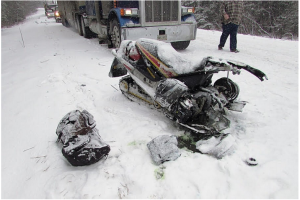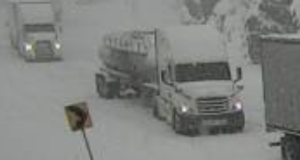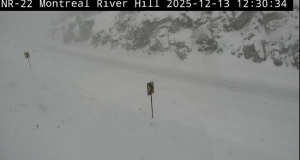Driving on forest roads is not like driving on the highway. Ontario’s forest roads are rugged unpredictable. These roads are rough, with sharp turns, wildlife, and large trucks. They often don’t have emergency services or cell phone coverage and have different challenges to regular highways.
“Every year there are severe and fatal accidents on Ontario’s forest roads,” says Chris Serratore, Health and Safety Services Director at Workplace Safety North (WSN), “and due to remote northern Ontario bush locations, it can take hours for help to arrive.”
In 2020, Ontario reported 15 snowmobile-related deaths and 168 injuries both on and off highway. While the data doesn’t focus specifically on forest roads, snowmobiles, ATVs, and other recreational vehicles often use these routes. To stay safe, drivers and recreational users need to slow down, stay alert, and be ready for unexpected hazards.
“WSN has been asked by northern forest companies to help raise awareness with the public who often use these roads for recreation. Whether you’re working or exploring, being prepared and driving cautiously can save lives.”
“Some people using forest roads are visitors from southern Ontario and they’re completely unfamiliar with the amount of logging activity happening. Drivers need to slow down, stay alert, and expect the unexpected.”
Common mistakes that can turn dangerous
- Speeding: Forest roads demand slower speeds. Loose gravel, narrow turns, and poor visibility make speeding a recipe for disaster. Even a small skid can send your vehicle into the trees or over a steep edge. Drive with caution, adjusting your speed to road conditions.
- Distracted driving: Skip eating or texting while driving – wildlife and forestry vehicles demand full attention. Fatigue is also a big concern on forest roads, especially after long hours. Stay alert and save the snacks and scrolling for later.
- Impairment: Alcohol, drugs, or fatigue dull reflexes—don’t risk it. With narrow passages, limited traction, and unexpected obstacles, sharp reflexes are essential.
- Skipping the seatbelt: You might feel tempted to forgo a seatbelt when you’re just “taking it slow” on these rough roads. But unpredictable surfaces and sudden stops mean that seatbelts are as essential in the forest as they are on the highway.
- Relying only on radio communications: Radio communication is crucial, but it can’t replace vigilance. Radios are essential for hearing other drivers’ locations, but they won’t always alert you to sudden obstacles or wildlife.
- Stopping in the wrong place: It’s tempting to pull over and admire a great view or snap a photo of wildlife, but doing so on a bridge, a curve, or narrow stretch of road is dangerous. Pull over in wide, visible areas – not on curves or bridges.
Extra challenges of collisions on forest roads
“Accidents on forest roads are more dangerous than on highways,” says Serratore. “Emergency services can take hours to arrive, and poor cell service makes calling for help difficult. Vehicles involved in crashes can catch fire, posing risks to occupants and the environment. If you’re driving alone, an emergency kit and survival supplies are a must.”
Forest roads are not highways
“Forest roads differ significantly from provincial highways,” says Serratore. “Many people expect similar conditions, but they’re in for a surprise.” Here’s what makes forest roads so unique:
- Washboard surfaces and large rocks: You’ll encounter surfaces that can jolt your vehicle or make it skid, so prepare to grip the wheel tightly.
- Soft shoulders and washouts: Some forest roads have shoulders that are soft or eroded. Avoid getting too close to the edge, as it can give way.
- Wildlife and road users: From moose to logging trucks, you’ll encounter many unexpected “road users.” Drive carefully, as these encounters can happen without warning.
- Dust, snow, and mud: Conditions change quickly, especially with Canada’s unpredictable weather. Be ready for limited visibility, slippery conditions, and even snow in unexpected places.
Legal responsibilities for employers and workers
“Employers and workers both play a role in maintaining safety on forest roads,” says Serratore. A few essential practices help ensure that all workers, supervisors, and employers fulfil their responsibilities. Employers should:
- Use the Internal Responsibility System: In Ontario, workplace safety is a shared responsibility. Employers need to identify what drives risky behaviour and address these issues. Whether it’s tight schedules or tough quotas, work pressures should not compromise safety.
- Maintain strong health and safety systems with regular training and protocols: Employers should put a strong health and safety system in place. This includes regularly reviewing and updating safety protocols, conducting training and audits, and ensuring that all workers know the best practices for driving on forest roads.
- Ensure accountability and training: Ensure drivers are trained on defensive driving, cargo securement, and radio communication. Employers should clearly outline everyone’s responsibilities to ensure all users understand how to stay safe on forest roads.
Working together to make forest roads safer
“Whether you’re a logging truck driver, a forestry worker, or a weekend explorer, we all share the goal of getting home safely,” says Serratore. “Forest roads offer some of Ontario’s most beautiful landscapes, but these roads demand respect, caution, and teamwork from everyone who uses them. “
With these guidelines in mind, your forest road journey can be both safe and enjoyable. So, buckle up, stay alert, and embrace the beauty of Ontario’s forests—safely.
Chris Serratore, Director of Health and Safety Services at Workplace Safety North, warns that forest access roads are far more dangerous than highways. With fewer signs, tight turns, and shared use by wildlife and heavy logging trucks, recreational users need to stay alert. Whether you’re working or exploring, being prepared and driving cautiously can save lives.
 This crash shows how dangerous forest roads can be if people don’t take the right safety measures. Every year, serious accidents happen on these roads. In 2020, there were 15 snowmobile deaths and 168 injuries both on and off-highway. Forest roads have sharp turns, wild animals, logging trucks, and no cell phone service, so drivers need to stay focused and ready for anything. To stay safe, slow down and always be prepared for the unexpected.
This crash shows how dangerous forest roads can be if people don’t take the right safety measures. Every year, serious accidents happen on these roads. In 2020, there were 15 snowmobile deaths and 168 injuries both on and off-highway. Forest roads have sharp turns, wild animals, logging trucks, and no cell phone service, so drivers need to stay focused and ready for anything. To stay safe, slow down and always be prepared for the unexpected.
SOURCE: Workplace Safety North
- Mixed Curling Standings – December 13 - December 13, 2025
- Ladies Curling Standings – December 12th - December 12, 2025
- Municipality of Wawa Partners with SECFDC to Administer Municipal Accommodation Funds - December 10, 2025
 Wawa-news.com You can't hear the 'big picture'!
Wawa-news.com You can't hear the 'big picture'!


